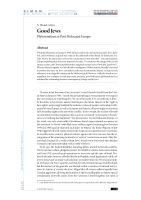Good Jews. Philosemitism in Post-Holocaust Europe
Author(s)
Publication Name
Publication Date
Abstract
While the liberation of Europe in 1945 did not result in the end of antisemitism, Jews, Judaism, and Jewishness acquired new value in the aftermath of the Shoah. In democratic Europe, the Jew became at the very least the “enemy that we now must love”. Like antisemitism, European philosemitic discourse mutated over time. To counteract the image of the Jewish enemy, secular and Christian philosemites imagined various types of loveable “good Jews”. This newfound sympathy was not devoid of ambiguities. Philosemitism, broadly conceived as positive discourse on Jews, can indeed easily recycle antisemitic themes, recreate Jewish otherness, or strategically compensate for Holocaust guilt. However, while the Israeli or cosmopolitan Jew continues to fuel antisemitic paranoia, post-Holocaust ‘philosemitism’ has redefined the relationship between contemporary Europe and its Jews.
Topics
Antisemitism Philosemitism Jewish - Christian Relations Jewish - Non - Jewish Relations Attitudes to Jews Main Topic: Other Post-War Jewish History Post-1989
Genre
Geographic Coverage
Copyright Info
S:I.M.O.N. operates under the Creative Commons Licence CC-BY-NC-ND (Attribution-Non Commercial-No Derivatives). This allows for the reproduction of all articles, free of charge, for non-commercial use, and with appropriate citation information.
Original Language
Volume/Issue
7
Page Number / Article Number
118-127
DOI
Link
Link to article including link to pdf, Good Jews. Philosemitism in Post-Holocaust Europe
Bibliographic Information
Good Jews. Philosemitism in Post-Holocaust Europe. 2020: 118-127. https://archive.jpr.org.uk/10.23777/SN.0120/ESS_DCOH01




